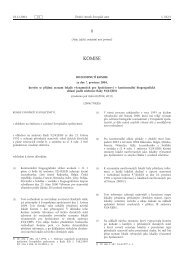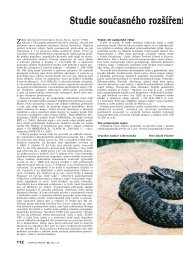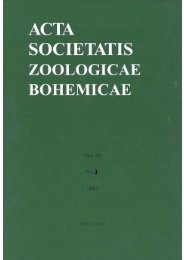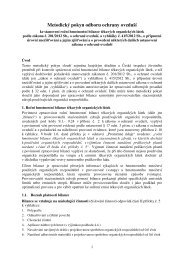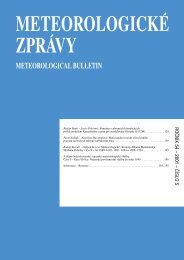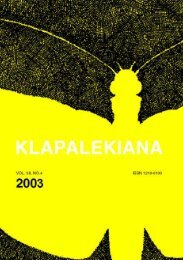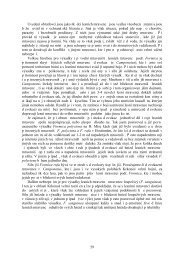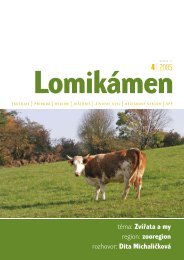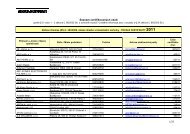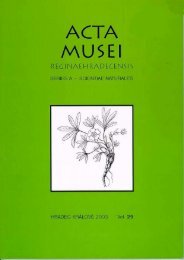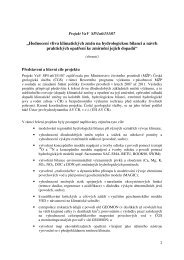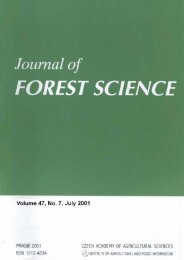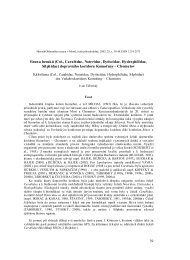Distribution and taxonomy of some Synapsis species, with ...
Distribution and taxonomy of some Synapsis species, with ...
Distribution and taxonomy of some Synapsis species, with ...
Create successful ePaper yourself
Turn your PDF publications into a flip-book with our unique Google optimized e-Paper software.
New ultra-evolved troglobite, Nauticiella stygivaga sp. n., is distinguished by its smaller body,<br />
moderately dilated basal protar<strong>some</strong>res <strong>and</strong> the extraordinary apical portion <strong>of</strong> its aedeagus. The<br />
genera Antroherpon, Croatodirus, Hadesia, Parantrophilon <strong>and</strong> Remyella can be distinguished<br />
from Nauticiella gen. n. by using the following key:<br />
1 (12) Antennal insertion on posterior third <strong>of</strong> head; mesosternal carina absent; protar<strong>some</strong>re IV not bilobed. ...<br />
......................................................................................................................................... Antroherponina<br />
2 (3) Antennomere I as long as antennomere II. Serbia. ..................................................... Remyella Jeannel<br />
3 (2) Antennomere I evidently longer than antennomere II.<br />
4 (5) Head widely oval, clearly wider than pronotum. Length 3.3–3.5 mm. Herzegovina. ................................<br />
....................................................................................................................... Parantrophilon Noesske<br />
5 (4) Head subcylindrical, elongate, at most slightly wider than pronotum. Length 2.5–9.1 mm.<br />
6 (9) Pronotum glabrous or <strong>with</strong> widely spaced long setae.<br />
7 (8) Labrum covered <strong>with</strong> numerous long bristles. Length about 7.5 mm. Herzegovina. ...... Hadesia J. Müller<br />
8 (7) Labrum <strong>with</strong> normal chaetotaxy. Length about 4.0–9.1 mm. Croatia, Bosnia, Herzegovina, Montenegro,<br />
Albania. .............................................................................. Antroherpon Reitter, Leptomeson Jeannel<br />
9 (6) Pronotum covered <strong>with</strong> dense decumbent pubescence.<br />
10 (11) Lateral margin <strong>of</strong> pronotum slightly convex (Fig. 18); apex <strong>of</strong> aedeagus acuminate (Fig. 27); parameres<br />
reaching apex <strong>of</strong> median lobe. Length 3.5–3.7 mm. Croatia. ....... Croatodirus Casale, Giachino et Jalži)<br />
11 (10) Lateral margin <strong>of</strong> pronotum anterior to posterior angles emarginate (Fig. 17); apex <strong>of</strong> aedeagus bilobed<br />
<strong>and</strong> dilated (Fig. 23); parameres not reaching apex <strong>of</strong> median lobe (Fig. 21, 22). Length 2.5–2.9 mm.<br />
Herzegovina. ............................................................................................................. Nauticiella gen. n.<br />
12 (1) Antennal insertion on posterior third <strong>of</strong> head; mesosternal carina reduced, forming a small triangular<br />
plate; protar<strong>some</strong>re IV deeply bilobed (Fig. 16). Croatia. ............ Leptodirina, Radziella Casale et Jalži)<br />
In its ecological requirements <strong>and</strong> the convergent adaptable morphological modifications <strong>of</strong> its<br />
mouthparts, especially the shape <strong>of</strong> the labrum <strong>and</strong> maxillae <strong>and</strong> dentate m<strong>and</strong>ibles N. stygivaga<br />
gen. n. et sp. n. is similar to <strong>species</strong> <strong>of</strong> Cansiliella Paoletti, 1972 from Italy (see Fig. 10) <strong>and</strong> both<br />
taxa <strong>of</strong> Tartariella Nonveiller et Pavi!evi), 1999 from the Durmitor Mts (Montenegro) (see Fig. 11,<br />
cf. Nonveiller & Pavi!evi) 1999: 323). The shape <strong>of</strong> the apex <strong>of</strong> the aedeagus <strong>of</strong> Albanodirus trezzii<br />
Giachino et Vailati, 1998, from Cave <strong>of</strong> Mt. Didja <strong>and</strong> Hali Salites (Oroshi, N. Albania) is also<br />
bilobed, but shallowly emarginate in dorsal view (Fig. 22).<br />
300<br />
Nauticiella stygivaga sp. n.<br />
(Figs 1, 4–6, 12–14, 17–24)<br />
TYPE MATERIAL. Holotype (male), labelled. “S Herzegovina, Popovo polje-plateau, Zavala Env., Pe)ina Vjetrenica<br />
Cave, 268 m a.s.l., 2.3 km from entrance, 27.viii.2001, R. Mlejnek lgt.”. Deposited in the collection <strong>of</strong> R.<br />
Mlejnek (Pardubice). Paratypes (4 males), the same data as holotype. In the collections <strong>of</strong> J. Moravec (Vrdy), M.<br />
Perreau (Paris) <strong>and</strong> R. Udržal (Pardubice).<br />
DESCRIPTION. Male (habitus <strong>of</strong> holotype as in Fig. 1). Length <strong>of</strong> body (measured from anterior<br />
margin <strong>of</strong> epistoma to apex <strong>of</strong> elytra) 2.5–2.9 mm (in holotype 2.7 mm).<br />
Head relatively large, narrower than pronotum; length/width ratio 1.17. Antenna (Fig. 12) rather<br />
long <strong>and</strong> slender, exceeding the apex <strong>of</strong> elytra; ratio <strong>of</strong> length <strong>of</strong> antenna/length <strong>of</strong> elytron 1.66–<br />
1.83 (in holotype 1.68); antennomere I longer than antennomere II (Fig. 13). Lengths <strong>of</strong> individual<br />
antennomeres I to XI (in mm) as follows: 0.20:0.16:0.32:0.29:0.39:0.34:1.02:0.27:0.27:0.18:0.22.<br />
Pronotum: length/width ratio 1.44–1.75 (in holotype 1.74). Lateral margins regularly arcuate in<br />
anterior half <strong>and</strong> sinuate in posterior third.<br />
Elytra elongate, moderately convex; length/width ratio 2.14–2.46 (in holotype 2.14). Lateral<br />
margins regularly rounded, bordered.<br />
Legs rather long <strong>and</strong> slender. Protibiae considerablely extended distally; length <strong>of</strong> protibia/<br />
length <strong>of</strong> protarsus ratio 1.7–1.79 (in holotype 1.78). Protarsus pentamerous, tar<strong>some</strong>re I long,



